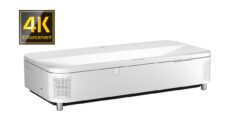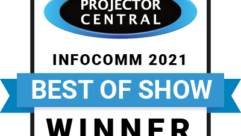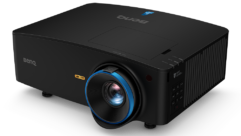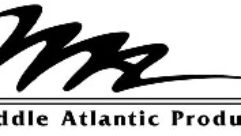
Picture This: InfoComm Trends
Jul 1, 2008 12:00 PM,
By Jeff Sauer
Today’s projectors and displays are more about better images and solutions.

Front: Sharp XG-P560W Back: Sharp XG-C455W
There was some interesting projector news from InfoComm 08, although it’s not the type of news from past years concerning brightness or smaller size. Instead, today’s projectors are increasingly about better images and better solutions, which should be good news for installers.
The most intriguing projector announcement this year was from Sanyo, highlighting better color performance. The new LP-XP200L is the successor to the older LP-XP100L, but it’s hardly an incremental upgrade. This model is the first 4LCD panel projector. It adds a yellow panel to the traditional array of red, green, and blue. It thereby broadens the color spectrum around green and reds. Sporting multiple primaries and adding extra colors aren’t new ideas, of course. Many DLP-based projectors add yellow or yellow and cyan color-wheel segments; however, those additional color-wheel sections are generally an effort to maintain high brightness while displaying saturated colors. LCD-based projectors don’t suffer as much from dimming, so the addition of a yellow panel is all about better color.
Ironically, Sanyo’s 4LCD projector announcement comes at the same time as the 3LCD consortium is pushing for an interesting new quantitative way to measure color performance. Unlike those aforementioned multi-segment color-wheel DLP projectors that often trade high brightness for accurate color or vice versa, the 3LCD consortium contends there is much less of a trade-off with LCD-based projectors. The consortium has proposed that the industry measure the individual brightness of red, green, and blue, and then compare the total of the three to the brightness of white — thereby tracking color brightness. It could be a revealing statistic for buyers interested in color accuracy as much as pure brightness. Naturally, that proposal would need some adjustment to accommodate the Sanyo XP200L, as well as the multi-segment color-wheel DLP-based projectors.
Short throw was one of the pleasantly surprising trends at InfoComm 08, with a particular effort made in integrating those short-throw units with custom mounts. Sanyo and Hitachi still lead the way in distance from the screen and projection angle. In fact, Sanyo followed last year’s ultra-short-throw PLC-XL50 with the new PLC-XL51, adding wireless connectivity features and more brightness (2700 lumens). Hitachi previewed its ultra-short-throw CP-A100 at CES in January, but it gave the model a decidedly installation slant at InfoComm with the CP-A100+FX77Duo Bundle that marries the lecture-room savvy of the ultra-short-throw projector with a Hitachi interactive whiteboard featuring the company’s mature StarBoard software. Plus, there’s an optional custom-designed and adjustable wall mount built for Hitachi by Peerless Mounts that puts the projector overhead and makes the whole solution a smart install for the integrator. BenQ (MP771) and Mitsubishi (XD500U-ST) also join existing short-throw solutions from 3M and NEC.
Canon has finally gone wide with one of two new LCoS-based Realis models. Interestingly, given the success of Canon’s camcorders business, the new WUX10 has a decidedly business-and-data bent with a native 1920×1200 resolution. Of course, with 1920×1200 pixels, the WUX10 can display HD 1080p video content pixel for pixel, but the back bars at the top and bottom indicate that Canon’s projector business is still focused on the core business market rather than the motion video of its sister camcorder business. As a business, commercial, or church production projector, the WUX10 makes a lot of sense for a combination of data and video sources. Its dense pixel grid affords a large-screen image with fine details, whether from text and numbers or moving images. Canon’s second projector introduction was its SX80, the 1400×1050 resolution successor to the SX60. A new chassis gives the SX80 a sleeker appearance, while new HDMI and USB ports offer new connection options — including computer-free presentations from a USB thumb drive.
Sony’s revamped line of 3LCD projectors boasts the new technology brand BrightEra, as well as aggressive new pricing and, in the case of the largest models, a wild new round chassis design. Those two large projectors, the VPL-FW300L and VPL-FH300L, feature native wide resolutions of 1366×800 and 2048×1080, respectively. They also offer an image and pricing step ($27,000 and $40,000) below Sony’s 4K installation projectors. The rest of Sony’s line of 3LCD projectors range in price from $1,050 to $7,350 with a variety of features.
Sharp Electronics added several new projectors to its business projector line-up, including the new 3-chip DLP XG-P560W — a 1280×800 native wide business projector — and two new 3LCD-based wide business projectors, also with native 1280×800 resolution. The DLP model leverages the brightness advantage of DLP micro-mirrors to reach as high as 6000 lumens. The XG-C455W and PG-C355W projectors feature 3LCD color performance, affordability, and brightness specifications of 4000 and 3300 lumens, respectively. Sharp also expanded its line of commercial/industrial LCD panels with 46in. and 52in. monitors that are suitable for public, educational, and corporate display. It also added a network version to its existing Sharp Digital Signage Software.
DIGITAL SIGNAGE
Sharp’s digital-signage solution wasn’t the only effort by a panel maker to aid customers with the content creation or content generation part of digital signage. Westinghouse Digital announced the M470SWP digital-signage solution — a combination of a 42in. or 47in. LCD panel, a set-top player device, and digital-signage creation software. Naturally, Westinghouse is not the first hardware manufacturer to try its hand at digital-signage software, and many of the other panel manufacturers haven’t met with great success. Yet the M470SWP shows promise with a simple-to-understand user interface and combination of background and layout templates and a film-strip organizational motif that brings drag-and-drop visual simplicity to playlist and program creation.
Philips again showed its WOWvx 3D LCD digital-signage panels — including the 42in. 42-3D6W02 — that use lenticular pixels so they not require viewing glasses. Philips now estimates that the panels will be available in Q4. At the same time, LG joined the party with a no-glasses-required 3D public-signage panel of its own. No release date was announced. LG also offered two other signage technology demonstrations: a triple-view LCD that is able to display three different images simultaneously with each visible at a different viewing angle and an LCD panel that becomes a mirror in lieu of displayed content.
3D was also present in several other booths; including ProjectionDesign. The F10 AS3D is the first single-projector stereoscopic solution, leveraging DLP’s extremely fast mirrors to display the content for both eyes independently. Da-Lite introduced the 3D Virtual Black, a screen specifically designed for stereoscopic content. The viewing angle was extremely narrow at 15 percent to 20 percent, but the 3D effect from the screen and a stereo pair of Christie projectors was very impressive.
For more InfoComm 08 coverage, see blog.svconline.com/infocomm and next month’s issue of SVC.










